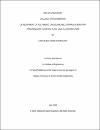Development of Polymeric Crosslinkable Formulations for Conformance Control In Oil and Gas Reservoirs
| Advisor | Hussein, Ibnelwaleed A. |
| Advisor | Nasser, Mustafa S. |
| Author | Shamlooh, Mohamed Saeed |
| Available date | 2020-07-15T10:32:59Z |
| Publication Date | 2020-06 |
| Abstract | Excessive water production from oil reservoirs is a main challenge facing the oil and gas industry nowadays. Polymers and crosslinkers are mixed to form gelants that are widely applied to seal water production zones leading to a more environment-friendly and economically-feasible production. While crosslinkers alternatives are limited and monopolized in the market, this thesis herein intends to explore other alternatives with improved performance for low and high temperature reservoirs. This thesis is divided into three main parts. The first part (chapter 4.a) intends to reinforce the conventional Polyacrylamide (PAM) /Polyethyleneimine (PEI) gelant using nanosilica as mechanical degradation is reported as shortcoming for this gel at high-temperature reservoirs. Differently sized nanosilica particles were investigated where the optimum reinforcement effect resulted from the 50 nm silica. The second part (chapter 4.b and 4.c) screens different functionalized silica based on the ability on crosslinking PAM. Gelation kinetics and rheological behavior of the newly developed systems were investigated nominating triamine-functionalized silica as an excellent replacement for Polyethyleneimine at high temperatures (>100 oC). The gel produced from PAM / triamine-functionalized silica was superior to all conventional gels with a gel strength of more than 5 times higher than the conventional PAM/PEI. The last part (chapter 4.d) screens different aluminum-based crosslinkers to replace the toxic chromium acetate, which is currently use. Aluminum Acetate (AlAc) was found to be the best among the screened inorganic crosslinkers in terms of gelation controllability, low settling rate, and viscoelastic behavior and temperature application window. Furthermore, PAM/AlAc gel was proven to be thermally stable in the range from 25 to 100 oC. Overall, the developed organic and inorganic crosslinkers have proven to work in the whole temperature range that is of interest to the oil and gas industry (25o-130oC) and have shown either equivalent or superior performance over the conventional crosslinkers. The application of the developed formulations is intended for water control as well as fracture sealing. The MS Thesis outcomes include: One filed US Patent, three published journal articles, and two submitted manuscripts. |
| Language | en |
| Subject | Conformance Control Water Shut-off Gelation Polyacrylamide Polyethyleneimine Nanosilica Aluminum crosslinkers |
| Type | Master Thesis |
| Department | Environmental Engineering |
Files in this item
This item appears in the following Collection(s)
-
Environmental Engineering [48 items ]


